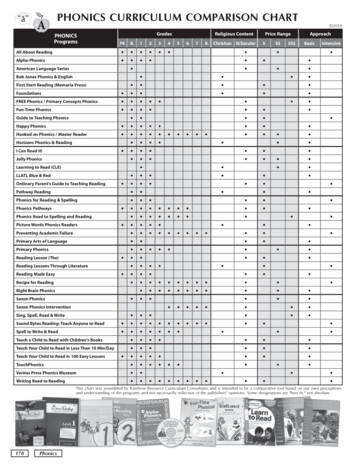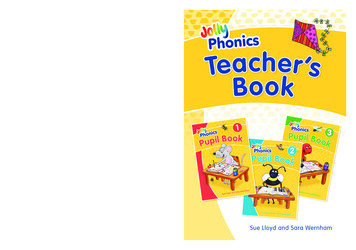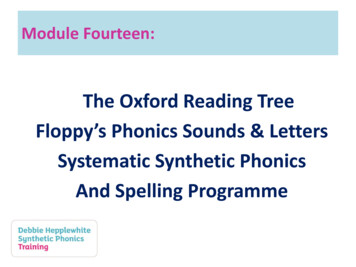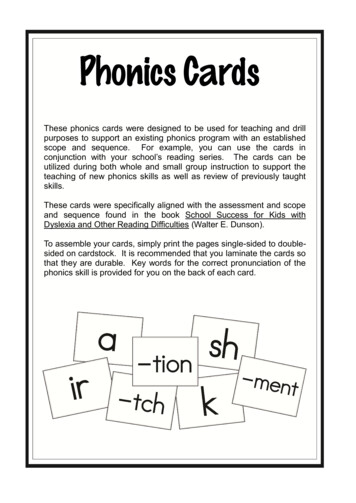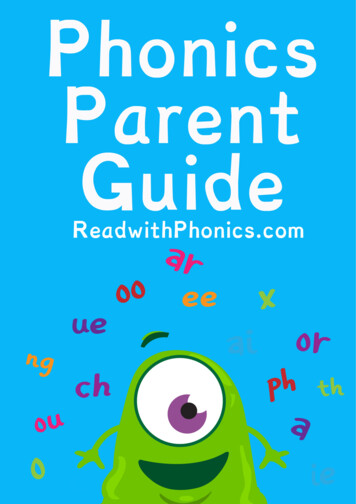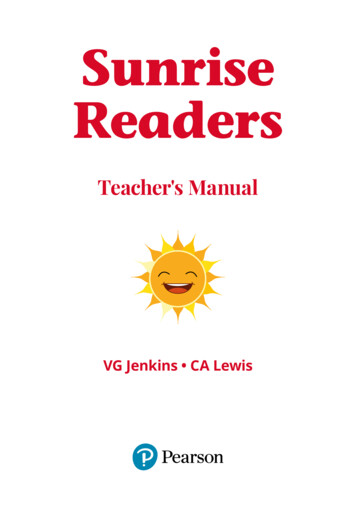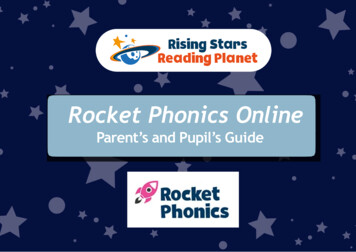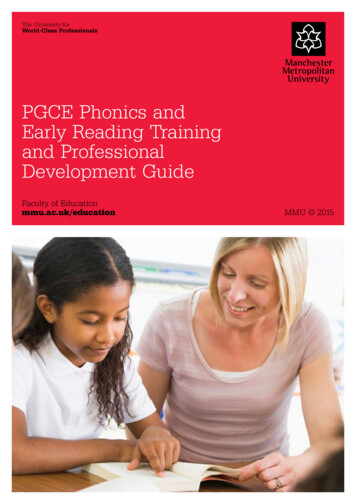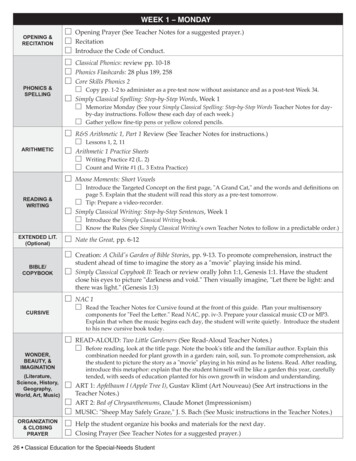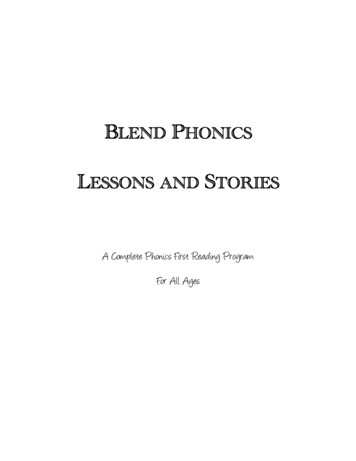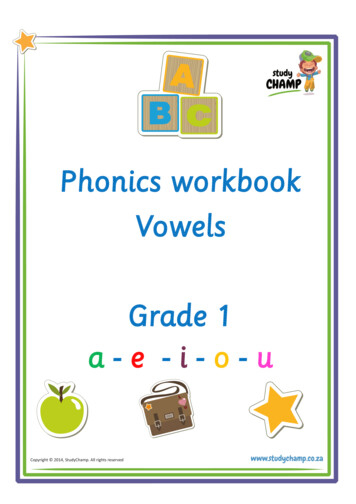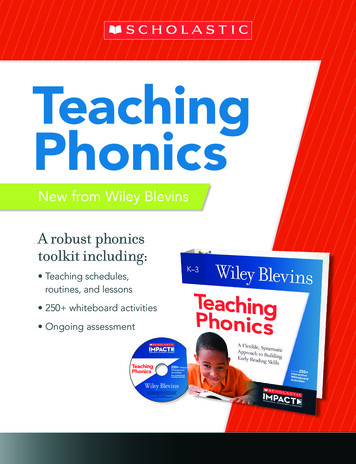
Transcription
TeachingPhonicsNew from Wiley BlevinsA robust phonicstoolkit including: Teaching schedules,routines, and lessons 250 whiteboard activities Ongoing assessment
Teaching Phonics, K–3With Teaching Phonics,Wiley Blevins has createda research-based resourcethat has the comprehensiveness to serveas a formal phonics programand the flexibility to augmentany curriculum. Teachers candeliver the lessons and activitiesin sequence, benefiting fromthe binder’s recurring routines and direct and explicitlanguage. Or they can dip in and out as needed, using the assessments andactivities for small-group differentiated instruction or individual interventions.The binder is designed to be versatile in its use and applicable to any scopeand sequence.Just as important, Teaching Phonics brings a sense of fun and collaborationto K–3 literacy learning. The ready-to-use stories, games, and activities offerchildren high-interest ways to learn. And the 250 whiteboard activitiesbring a fresh, full-color interactivity to teaching and learning that will engageany young learner. You’ll quickly discover that there’s no better resource forhelping build the early skills young children need to become confident andsuccessful readers.INCLUDES: Sample teaching schedules, researchbased lessons, and instructional routines Activities for whole-class, small-group,and independent practice CD with 250 interactive whiteboardactivities Ready-to-use learning centers,interactive stories, and more 68 units that focus on essential alphabet,phonics, and word study skills Phonemic awareness, alphabet,and phonics assessments Guiding principles to help supportEnglish language learnersUVJ-531344 604 pages CDList price: 234.99 Your price: 177.002
An Effective, Affordable Solution for Building Early Reading SkillsFrequently Asked QuestionsWhy do we need this programwhen our basal already hasa phonics strand?Your teachers can use TeachingPhonics as an enrichment resource foron- and below-level students or as anacceleration for above-level students.The reproducible student pages and250 interactive whiteboard activitiesprovide engaging opportunities fortargeted practice. Teachers can assignthe ready-made learning centersor independent practice pages forhomework or use them for reteachingand remediation.Is Teaching Phonics researchbased?Are there assessments so weknow the instruction is working?Yes, an assessment is provided foreach major set of skills in the binder(for example, short-vowel assessment,long-vowel assessment). Teachers canadminister the assessment after finishingthat section to determine if students areready to take on the next set of skills.The assessments can also be used todetermine where in the materials to startindividual students.Can we use this programin PreK–K classrooms?If you’re looking for extended letter-workinstruction only, your teachers shouldconsider using Teaching the Alphabet,PreK–K, instead (see back cover). Forkindergarten teachers who want to makethe transition to decodable, connectedtext as quickly as possible, TeachingPhonics is a better match.Yes, the materials in this resource offer aresearch-based, systematic, and explicitapproach to phonics instruction. It’s asystematic program in that the materialscan be used in sequence. It’s explicitbecause the lessons provide teachers withdirect and actual language to use whileHow do we use this program inteaching.first grade? Or second grade?Will this program help usmeet the Common Core StateStandards?Absolutely, and your specific statereading and language arts standards, too.For more information, see page 10.Does Teaching Phonics supportguided reading?Teaching Phonics is an ideal resource forguided reading classrooms. Learn howon page 11.Or third grade?Most first graders are ready to jumpright in to simple decoding so teacherscan start with the short-vowel lessons.Grade 2 teachers may want to quicklyreview previously taught skills, then assiststudents in making the transition fromreading one-syllable to multisyllabicwords. By third grade, teachers canfocus attention on word study withlessons that include the six syllabletypes or use the resource to deliversmall-group instruction for studentswho are struggling.ABOUT WILEYBLEVINSWiley Blevins is aHarvard Universitytrained readingspecialist andformer elementaryteacher. He haswritten severalScholastic texts,including Phonicsfrom A to Z:A Practical Guide,Teaching Phonics& Word Study inthe IntermediateGrades, andTeaching theAlphabet, PreK–K(see back cover).He also led thedevelopmentof Treasures—a core readingprogram publishedby McGraw-Hill—and has helpedconceptualize manyother programs.www.Scholastic.com/IMPACT3
First come the ABC’s . . .Alphabet lessons and routinesthat build skills and automaticityTo become skilled readers, children must be able to identify words quickly and accurately.And to do that, they need to learn the most common sound-spelling relationships,beginning with the alphabet. The 27 alphabet units in Teaching Phonics follow an explicitsix-step process to guide teachers as they introduce students to letter-sound relationshipsand basic alphabet-recognition and decoding skills. This is just a sampling of what comeswith each unit. Opportunities for writing practice, picture-sound sorts, and storybooks arealso available as interactive whiteboard activities on the CD (see pages 8–9).Teaching Phonics’ explicit six-step processfor teaching the alphabet:1 PRACTICE PHONEMIC AWARENESS.Teaching the Letter: AaIWBInteractiveWhiteboardActivitiesSee Instructional Routines, pages 25–28, for additional lesson details and support.IWB This icon indicates that the CD includes an interactive whiteboard versionof the activity that can be used for small-group or whole-class learning.1Practice Phonemic Awareness: Have children say /a/ every time theyhear a word that begins with the /a/ sound. (Note: The word lists that followinclude distractors.) Say: at, apple, ball, add, car, on, ax. Repeat for words with /a/in the medial position. Say: man, hot, tap, bat, bed, rug, cat, sad. Extend the medialsound as you pronounce each word. Point out how the /a/ sound is made (mouthopen). Contrast with other vowel sounds, such as /o/. Have children feel thedifference in their mouths when making each sound.2Handwriting PracticeTeach the Letter Name/Sound: Tell children that the letter Aa standsfor /a/ as in apple. Then teach children the following letter chant:2 TEACH THE LETTER/NAME SOUND.Picture-Sound Sort/a/ /a/ apple.Bite that juicy apple./a/ /a/ /a/ is spelled Aa. eaching tips describe how to connect each letter to aTmnemonic chant that emphasizes the letter-sound connection.The CD includes an audio of the chant.3Write the Letter: Use Handwriting Practice: Aa, page 44, to teach childrenhow to write the upper- and lowercase forms of the letter Aa. Introduce thesound-spelling using the letter chant. Then have children say the /a/ sound each timethey write the letter. Also contrast Aa with other similar letters (a-d, a-o). Point out thestroke differences between the confusing letter pairs. IWBStorybook4Sort by Letter/Sound: Use Picture-Sound Sort: Aa, page 45, to havechildren sort pictures whose names contain /a/ in the initial and medialpositions. (Answers: Beginning—alligator, ambulance, ant, apple, astronaut, ax;Medial—bag, bat, cat, fan, map, pan) IWB3 WRITE THE LETTER.ABC Caterpillar5Connect to Reading: Distribute copies of Storybook: What Am I?,page 46. Help children read the book. Then invite them to reread the bookduring free time and at home. IWB6Extend Letter Knowledge: Choose from the following patterns andactivities to extend learning. (These pages are available as PDFs on the CD.) Picture Patterns: Ant, Apple Learning Center: ABCPicture PatternsTo the Teacher: Copy and cut out the ant and apple patterns. Use the pictures for instructionalactivities, center games, and bulletin boards.AaLearning CenterLearning CenterTo the Teacher: Copy, cut out, and glue the directions to the front of a zipper storage bag, folder,or large envelope. Also copy and cut out the Caterpillar Parts (enlarge, if desired), and place them inside.Caterpillar PartsgkoasdwhlpbtexDirections:Children create the caterpillar by placing the parts in ABC order. Independent Activity: I AmTeaching Phonics: K–3 2011 by Wiley Blevins, Scholastic Teaching ResourcesPicture PatternsCaterpillar PartsAa AaimqcufyABC CaterpillarCaterpillar IWBjnrvzTeaching Phonics: K–3 2011 by Wiley Blevins, Scholastic Teaching ResourcesTeaching Phonics: K–3 2011 by Wiley Blevins, Scholastic Teaching ResourcesLearning CenterIndependent ActivityI AmWrite am on the blank line to complete each sentence.Read each sentence to a partner.1. I3. I4. I5. Iam aam aam aam aam a.Teaching Phonics: K–3 2011 by Wiley Blevins, Scholastic Teaching ResourcesIndependent ActivityTeaching Phonics 2011 by Wiley Blevins, Scholastic Teaching Resources4AaName2. IEach unit begins with a lesson routine page that offers explicitguidelines and language for introducing the target letter-sound,including word lists to be read out loud and suggestions fordemonstrating how the letter-sound is made.www.Scholastic.com/IMPACT43On a practice page, students write upper- and lowercase formsof each letter, both in formal instruction and guided practice.The lesson routine page provides tips for contrasting the targetletter with similar-looking letters.
Aa4 SORT BY LETTER/SOUND.Picture-Sound SortPicture-sound sorts enable children to exploreletter-sound relationships in both unstructuredand structured ways. The lesson routine pageoffers suggestions on different ways to sortthe cards.To the Teacher: Copy and cut out the pictures. Have children sort them accordingto sound (beginning, or words containing medial /a/).Aa5 CONNECT TO READING.Simple, patterned storybooks highlight targetskills and utilize a few high-frequency words—students’ first introduction to reading.StorybookTo the Teacher: Distribute copies of the Storybook. Invite children to color and thencut apart the pages. Have them staple the pages together along the left-hand side.Help children read the story.What Am I?Additional activities are available as needed,including picture patterns, learning centers,and independent activities for use duringsmall-group differentiated instruction timeor as homework.Teaching Phonics 2011 by Wiley Blevins, Scholastic Teaching Resources6 EXTEND LETTER KNOWLEDGE.I am a cat.I am a bat.21Don’t forget to assess!I am a rat.Random OrderMix ScoreIndividual Scoring SheetAlphabet AssessmentNameDateUppercase LettersNumber correct:Speed: q slow/laboredq moderateq fastSpeed: q slow/laboredq moderateSpeed: q slow/laboredq moderatefor each testing period to determine small-group differentiated instructional GlaiyBPmfhRLvKUcZWdTysjTeaching the Alphabet 2011 by Wiley Blevins, Scholastic Teaching ResourcesNameAlphabet Assessment: Part 1Upper- and Lowercase Letters in OrderChildren recognize uppercase and lowercase letters in order.A B C D E F G H IJ K L M N O P Q R1. Display Alphabet Assessment: Part 1.S T U V W X Y Z2. Have the child point to each letter in order as he or she says the letter’s name. Circlea b c d e f g h ieach correct response. Record the child’s errors to use for error analysis. Then recordthe number correct and note the speed in the boxes on the Alphabet Assessment:Individual Scoring Sheet.j k l m n o p q rs t u v w x y z430Part 2Teaching the Alphabet 2011 by Wiley Blevins, Scholastic Teaching ResourcesNameAlphabet Assessment: Part 2Upper- and Lowercase Letters in Random OrderChildren recognize a sampling of uppercase and lowercase letters in random order.E BP fi am Rv KZ Wy1. Display Alphabet Assessment: Part 2.2. Have the child point to each letter as he or she says the letter’s name. Circle eachcorrect response. Record the child’s errors to use for error analysis. Then record thenumber correct and note the speed in the boxes on the Alphabet Assessment: IndividualScoring Sheet.oNqLUdshxGjcT429Teaching the Alphabet: PreK–K 2011 by Wiley Blevins, Scholastic Teaching Resources432NameAlphabet Assessment: Part 3Match Upper- and Lowercase LettersChildren match uppercase to lowercase letters.r Ko Ml Qz Ok NyGa Ee Ji Rq St WwVu Fb Lj Zp Ts XnUgYmATeaching the Alphabet 2011 by Wiley Blevins, Scholastic Teaching Resourcesthe child’s errors to use for error analysis. Then record the number correct and notethe speed in the boxes on the Alphabet Assessment: Individual Scoring Sheet.CLTb434Part 12. Have the child draw lines to match the upper- and lowercase letter forms. RecordBKasq fastUpper-LowercaseRandom Order MixNumber correct:q fast1. Distribute Alphabet Assessment: Part 3.AJSLowercase LettersNumber correct:3. Use the Alphabet Assessment: Class Record Sheet to gather and record all children’s scoresPart 34Letter-SoundScoreLetter MatchScoreUppercaseLetters ScoreAssessment #3DateLowercaseLetters ScoreRandom OrderMix ScoreLetter-SoundScoreLetter MatchScoreLetter-SoundScoreUppercaseLetters ScoreAssessment #2DateLowercaseLetters ScoreLowercaseLetters ScoreRandom OrderMix ScoreChild’s NameTeaching the Alphabet 2011 by Wiley Blevins, Scholastic Teaching Resourcesand the Alphabet Assessment: Individual Scoring Sheet, pages 574–575. Also makea copy of the Alphabet Assessment: Class Record Sheet, page 576.462. Administer the assessment to each child in the class three times a year—at thebeginning, middle, and end.What am I?Alphabet Assessment: Class Record SheetLetter MatchScore31. Make a class supply of the Alphabet Assessments (Parts 1–4), pages 570–573,UppercaseLetters ScorePreparationAssessment #1DateAssessment Directions: Alphabet436Available both in the binder and on theCD as PDFs, the phonemic awareness andalphabet assessments contain a series ofsubtests, allowing for overall and individualsub-skill area scores. Also included are explicitguidelines on how to prepare and administerthe tests, along with record-keeping forms.Teaching Phonics 2011 by Wiley Blevins, Scholastic Teaching Resources45Cc Bv Dd Hf Ih PxPart 4Children identify the primary sound for each letter.1. Display Alphabet Assessment: Part 4.2. Have the child point to each letter and state the sound it represents. Circle each correctresponse. Record the child’s errors to use for error analysis. Note that some lettersrepresent multiple sounds, for example, the short and long sound for vowels. Recordand accept any correct response. Then record the number correct and note the speedin the boxes on the Alphabet Assessment: Individual Scoring Sheet.Teaching Phonics 2011 by Wiley Blevins, Scholastic Teaching ResourcesNameAlphabet Assessment: Part 4Letter-SoundsaeimquybfjnrvzcgkoswTeaching the Alphabet: PreK–K 2011 by Wiley Blevins, Scholastic Teaching Resourcesdhlptx4315695
Then come phonics and word study. . .Phonics lessons and routinesthat jumpstart readingOnce students have mastered the alphabet, the focus is on building phonics andword study skills. An explicit nine-step process leads teachers through each ofthe 27 phonics units, including short vowels, consonant blends and digraphs, long vowels,and complex vowels. They’re followed by 14 word study lessons, which vary slightly andinclude only seven steps. Interactive stories and activities are also available on the CDfor your whiteboard (see pages 8–9). As always, teachers should choose those activitiesthat interest them or best complement their instructional needs.Teaching Phonics’ explicit nine-step processfor teaching phonics and word study:1 INTRODUCE THE igraphs ng, nkSee Instructional Routines, pages 29–32, for additional lesson details and support.IWB This icon indicates that the CD includes an interactive whiteboard versionof the activity that can be used for small-group or whole-class learning.1Build WordsIntroduce the Sound-Spelling: Tell children that when the letters ngand nk appear together in a word, they stand for new sounds—the /ng/ soundin ring and the /ngk/ sounds in pink. Write the letters ng and nk on the board. Havechildren write the spellings several times as they say the sounds each stands for.2Model Blending: Write the words rig, ring, king, ban, bank, and sink on theboard. Model blending the words sound by sound. Run your finger undereach letter or spelling as you say the sound(s). Emphasize the sound(s) of ng and nkin words containing either digraph spelling. Have children repeat.Sound-Spelling Word SortSpell WordsInteractive Story3Blend Words: Use Blend Words: Digraphs ng, nk, page 293, to have childrenchorally blend the words on each line. Model, as needed. Children can thenuse the lists for further independent practice. Also encourage children to completethe Do More! activities.4Build Words: Using the letter cards on Build Words: Digraphs ng, nk,page 294, have children build the following words in sequence: ring, sing,sang, bang, rang, ring, bring, thing, think, thank, sank, rank, rink, sink, stink, shrink,shrunk, hunk, junk. Then have children complete the activities on the page. IWB56Sort Words: Use Sound-Spelling Word Sort: Digraphs ng, nk, page 295, to havechildren work with partners to sort the words by their sound-spellings. IWBSpell Words: Use Spell Words: Digraphs ng, nk, page 296, to give childrenpractice spelling the letter-sounds in different picture names. (Answers: r-i-ng,k-i-ng, s-i-nk, s-w-i-ng, s-k-u-nk) Then have them spell the following words as youdictate each one: sing, pink, thing, spring, and drink. Display the words and havechildren self-correct their answers. IWB7Trunk SortConnect to Reading: Distribute copies of Interactive Story: King Hank,page 297. Read the story with children several times. Model blending, asneeded. Then have children independently complete the questions and prompts.Have children reread the story multiple times for fluency. IWB8Build Fluency: Use Speed Drill: Digraphs ng, nk, page 298, for additionalfluency building. Begin by giving students two minutes to underline the ng ornk digraph in each word. Then have them practice reading the words independentlyto prepare for the one-minute speed drill.9Extend Phonics Knowledge: Use the following activities to extendlearning. (Specific teaching notes appear on these pages.) Learning Center: Trunk Sort, pages 299–301 IWB Independent Activity: Fill-in-the-Blank, page 3022926Teaching Phonics 2011 by Wiley Blevins, Scholastic Teaching Resourceswww.Scholastic.com/IMPACT ach unit begins with a lesson routine page that providesEexplicit guidelines and language for introducing the targetsound-spelling or word study skill.2 MODEL BLENDING. eaching tips model how to use the target sound-spellingTto blend words, using a small set of decodable words.3 BLEND WORDS. his carefully constructed practice opportunity asks studentsTto apply their understanding of the new sound-spelling orword study skill, with the help of high-utility words containingthe target phonics skill.4 BUILD WORDS.Letter cards for building a particular set of words offer astructured method for helping students go from one word toanother as they consider the sound and spelling differencebetween two very similar words.
5 SORT WORDS.AaDigraphsng, nkSound-Spelling Word Sort ords sorts provide structured and unstructuredWopportunities to explore sound-spelling relationshipswith common spelling patterns.To the Teacher: Distribute copies of the page (enlarge, if desired), and have children cut outthe word cards, then work with partners to sort the words by their sound-spellings.NameRead each word. Then sort the words.ng6 SPELL WORDS.nk hese activities guide students as they connect their newTreading skills to writing through structured dictation. imple stories and poems highlighting the target skill enableSstudents to use their growing phonics knowledge to decodewords. Follow-up questions check their comprehension,including students’ ability to identify words in the text withtarget sound-spellings.8 BUILD FLUENCY.Speed drills are a motivating way for students to practicereading high-utility words containing the target skill untilperiodic timing proves they can read with fluency.9 EXTEND PHONICS KNOWLEDGE.Ready-made learning centers and independent activitiescan be assigned as needed for group work, seatwork,or homework for skills practice.Don’t forget to assess!All of the phonics assessments—available both in the binderand on the CD as PDFs—are real-world reading tests, withexplicit guidelines for teachers on how to prepare andadminister the tests along with record-keeping forms. There’salso a Comprehensive Phonics Survey, a nonsense-wordreading test to confirm findings in the other assessments.Teaching Phonics 2011 by Wiley Blevins, Scholastic Teaching Resources7 CONNECT TO READING.Word Cardsthank gang pink ring junkstrong bank thing spring kingdrink hang shrunk song honk295NamePage 1Comprehensive Phonics SurveyNonsense-Word ReadingA. Short pyotrudcagB. Consonant Blendsand bruckclisssmendthristphumTeaching Phonics 2011 by Wiley Blevins, Scholastic Teaching Resources7
Brought to life on a whiteboard . . .Interactive whiteboard activitiesthat bring a fresh spin to learningWith its large display and countless opportunities for collaborative learning, aninteractive whiteboard is a dynamic new way to bring phonics instruction and practiceto life. Many of the activities in Teaching Phonics are available on the companion CD for useon your interactive whiteboard or computer; just look for the icon: IWB . The activitieshave all been carefully designed for use during whole-group and small-group instruction.They’re also ideal for partner practice during classroom center time. Whether your teachersare first-time users or seasoned pros, they’ll quickly discover the interactive whiteboardactivities couldn’t be easier to use.A closer look at some of the whiteboard activitiesin a typical lesson:8MAIN MENUBUILD WORDSClick on the activity title to go tothat whiteboard activity page.Teaching notes guide you step bystep through the lesson.www.Scholastic.com/IMPACT
SOUND-SPELLING WORD SORTSPELL WORDSA sample self-correcting drag-and-dropsorting activity.An answer key lets childrencheck their work instantly.INTERACTIVE STORYLEARNING CENTERThe Pen function lets children interactwith the text by circling words containingthe target phonics skill.These games and activities often includeinteractive spinners, number cubes,timers, and stopwatches.9
. . . making it a powerful & purposeful resourceWith correlations to help meet theCommon Core State Standards. . .Teaching Phonics is the perfect resource for helping teachers meet—and exceed—the goals of the CCSS in these critical primary years. There’s a recommended scopeand sequence for each grade, based on a careful review of state standards and existingbasal scopes and sequences, as well as the CCSS Foundational Skills for Reading.Suggested sequences and correlations are provided for all of the primary grades:Kindergarten and Grades 1, 2, and 3. Below is a partial sample from Grade 2.Grade 2: Suggested SequenceGrade 2: Common Core State StandardsThe focus in Grade 2 is building mastery/fluency withthe skills taught in Grade 1, and applying these skills toincreasingly larger numbers of multisyllabic words and morecomplex texts.Phonics and Word RecognitionShort Vowelsa, i, o, e, uReview.Consonant Blends and Digraphss-blends, l-blends, r -blends, digraph sh, digraph wh,digraphs ch/tch, digraph th, digraph ph, digraphs ng/nkReview and apply these skills to previously taught short-vowelwords.Long Vowelsfinal e, long a, long e, long o, long i, long uReview long vowels.Complex Vowelsr-controlled vowels er, ir, urr-controlled vowels ar, or, orediphthongs ou, owdiphthongs oi, oyvariant vowels oovariant vowels a, au, awr-controlled vowels are, air, earReview complex vowels.Word Studyplurals, inflectional ending -ed, inflectional ending -ing,contractions, inflectional endings with spelling changes,compound words, prefixes, suffixes, closed syllables, opensyllables, consonant le syllables, vowel-team syllables,r-controlled syllables, final-e syllables10www.Scholastic.com/IMPACT3. Know and apply grade-level phonics andword analysis skills in decoding wordsa. D istinguish long and short vowels when readingregularly spelled one-syllable words.b. K now spelling-sound correspondencesfor additional common vowel teams.c. D ecode regularly spelled two-syllable words withlong vowels.d. D ecode words with common prefixesand suffixes.e. I dentify words with inconsistent but commonspelling-sound correspondences.f. R ecognize and read grade-appropriate irregularlyspelled words.Fluency4. Read with sufficient accuracy and fluencyto support comprehension.a. R ead on-level text with purpose and understanding.b. R ead on-level text with accuracy, appropriate rate,and expression on successive readings.c. U se context to confirm or self-correct word recognitionand understanding, rereadingas necessary.
. . . and valuable phonics supportfor guided reading classroomsTeaching Phonics’ lesson routines, activities, and centers are all a perfect fit for guidedreading classrooms. Teachers can use the lessons to preteach the phonics skillsstudents will encounter in that day’s guided reading, then assign word work and otherreading and writing activities for independent practice while they meet with guidedreading groups. There are also correlations recommending the skills most appropriatefor each guided reading level.GuidedReadingLevelFocus Phonics Skill(s)GuidedReadingLevelFocus Phonics Skill(s)AAlphabetChildren read patterned text.Ir-Controlled Vowels er, ir, ur, ar, or, oreDiphthongs oi, oy, ou, owVariant Vowels oo, au, awBAlphabetChildren read patterned text.J2–3 Syllable WordsReview one-syllable words with short vowels,final e, blends, and digraphs to ensure mastery.CAlphabetChildren read patterned text with a few shortvowel VC and CVC words.K2–3 Syllable WordsReview one-syllable words with long vowels,inflectional endings, and plurals to ensuremastery.L2–3 Syllable WordsReview one-syllable words with long vowelsto ensure mastery. Instruction can also includesilent letters and soft c/g.DEShort Vowels a, oChildren begin reading decodable text.Instruction can also include inflectional endings,consonant blends, and plurals.Short Vowels i, e, uInstruction can also includeconsonant digraphs.M2–3 Syllable WordsReview one-syllable words with r -controlledvowels, variant vowels, and diphthongs toensure mastery.NSyllabicationInstruction should include open syllables,closed syllables, consonant le syllables,and prefixes.OSyllabicationInstruction should include vowel-team syllables,final-e syllables, r-controlled vowel syllables,and suffixes.PSyllabicationInstruction should include inflectional endingswith spelling changes, prefixes, suffixes, andhomophones.Final eFLong Vowels a, eGHLong Vowels o, iInstruction can also focus on introducing simplemultisyllabic words.11
Need a dedicated alphabet program for PreK--K?ALSO BY WILEY BLEVINS:Teaching the Alphabet, PreK--KA Flexible, Systematic Approachto Building Early Phonics SkillsTo learn our all-important sound-spelling system, young childrenneed instruction that is purposeful, connected, and engaging.And it all begins with learning the ABC’s. Teaching the Alphabet,PreK–K, contains a wealth of print and digital resources forteaching the basic alphabet-recognition and decoding skillschildren need to understand how our written system of Englishworks. It’s ideally suited for PreK–K teachers who want to focuson—or offer extra practice in—letter-work instruction.UVJ-531343 400 pages CDList price: 185.00 Your price: 139.00For more information, contact us!WEST REGIONEAST REGIONPHONE: 1-888-757-5139NATIONAL FAX LINE: 1-877-242-5865EMAIL: SCCGWest@scholastic.comPHONE: 1-866-757-5163NATIONAL FAX LINE: 1-877-242-5865EMAIL: SCCGEast@scholastic.comAlaska, Arizona, Arkansas, California, Colorado,Hawaii, Idaho, Illinois, Iowa, Kansas, Louisiana,Minnesota, Mississippi, Missouri, Montana, Nebraska,Nevada, New Mexico, North Dakota, Oklahoma,Oregon, South Dakota, Texas, Utah, Washington,Wisconsin, WyomingAlabama, Connecticut, Delaware, Florida, Georgia,Indiana, Kentucky, Maine, Maryland, Massachusetts,Michigan, New Hampshire, New Jersey, New York,North Carolina, Ohio, Pennsylvania, Rhode Island,South Carolina, Tennessee, Vermont, Virginia,West VirginiaTMwww.Scholastic.com/IMPACTItem #609111
Ongoing assessment Teaching Phonics New from Wiley Blevins. 2 With Teaching Phonics, Wiley Blevins has created a research-based resource that has the comprehensiveness to serve as a formal phonics program an
